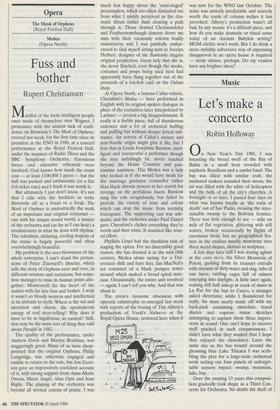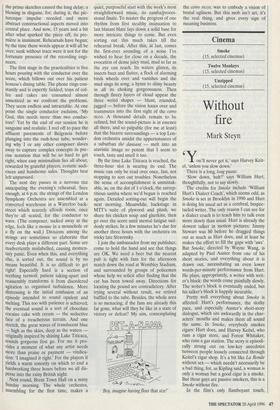M us ic
Let's make a concerto
Robin Holloway
n New Year's Day 1981, I was breasting the broad swell of the Bay of Bahia in a small boat crowded with euphoric Brazilians and a samba band. The bay was filled with similar craft, the anchored tankers sounded their sirens, the air was filled with the whirr of helicopters and the bells of all the city's churches. A fortnight or so later, I passed four days on what was known locally as 'the train of death' out of Sao Paulo, crossing the inter- minable swamp to the Bolivian frontier. There was little enough to see — mile on mile of flat vegetation, glittering with still waters, broken occasionally by flights of enormous birds; but no geographical fea- ture in the endless muddy monotony save three weird shapes, distinct as sculpture.
A few days later still I was staring aghast at the cerro ricco, the Silver Mountain of Potosi, gushing from its treasury entrails with streams of dirty water and slag, tubs of raw lucre, rattling cages full of miners emerging into daylight. A little later again, waiting still half asleep at crack of dawn in La Paz for the bus to Cuzco, a stranger asked directions; while I floundered for reply, his mate neatly made off with my back-pack containing chocolate, travel diaries and copious music sketches attempting to capture these three impres- sions in sound. One can't hope to recover stuff pinched in such circumstances. I didn't have what they wanted (but I hope they enjoyed the chocolate). Later the same day as the bus wound around the gleaming blue Lake Titicaca I was scrib- bling the plan for a large-scale orchestral work setting out four panels of unforget- table sensory impact: swamp, mountain, lake, bay.
Over the ensuing 13 years this composi- tion gradually took shape as a Third Con- certo for Orchestra. No doubt the theft of the prime sketches caused the long delay; a blessing in disguise, for, during it, the pic- turesque impulse receded and more abstract constructional aspects moved into central place. And now, 15 years and a bit after what sparked the piece off, its pre- mière is imminent. Rehearsals have begun; by the time these words appear it will all be over; sunk without trace were it not for the fortunate presence of the recording engi- neers.
The first stage in the practicalities is five hours pouring with the conductor over the score, which billows out over his patient hostess's dining table. The phone rings con- stantly and is expertly fielded; trays of cof- fee and cakes are consumed almost unnoticed as we confront the problems. They seem endless and intractable. At one point the single conductor exclaims, 'My God, this needs more than two conduc- tors!' Yet by the end of our session he is sanguine and realistic. I reel off to pace the affluent pavements of Belgravia before plunging into the rush-hour tube, wonder- ing why I or any other composer slaves away to capture complex concepts in pre- cise notation that will be so hard to get right, when easy minimalism lies all about, rewarded by grateful players, ecstatic audi- ences and handsome sales. Thoughts best left unpursued.
The next day passes in a nervous tizz anticipating the evening's rehearsal. Sure enough, at 6 p.m. the strings of the London Symphony Orchestra are assembled at a converted warehouse in a Waterloo back- street which scarcely affords room, once they're all seated, for the conductor to wave. (The composer, tucked away at the edge, feels like a mouse in a mousehole or a fly on the wall.) Divisions among the strings are sometimes so elaborate that every desk plays a different part. Some are inadvertently mislabelled, causing momen- tary panic. Even when this, and everything else, is sorted out, the sound is by no means beautiful. It is so difficult to get right! Especially hard is a section of seething turmoil; patient taking-apart and reassembly transforms it from disordered agitation to organised turbulence. More distressing is the initial confusion of an episode intended to sound opulent and melting. This too with patience is achieved; the eventual sound is a sort of chocolate cocaine cake with cream — the seductive face of a treacherous terrain. And one stretch, the great waves of translucent blue — high as the skies, deep as the waters originally inspired by shining Lake Titicaca, sounds gorgeous first go. For me it pro- vides a moment of what any artist needs more than praise or payment — vindica- tion: 'I imagined it right.' For the players it yields a warm sonority on which to end a hardworking three hours before we all dis- perse into the rainy British night.
Next round, Brent Town Hall on a misty Sunday morning. The whole orchestra, assembling for the first time, makes a quiet, purposeful start with the work's most straightforward music, its samba/proces- sional finale. To master the progress of one rhythm from first stealthy insinuation to last blatant blare lays down a solid base for more intricate things to come. But even sorting out this much takes till the rehearsal break. After this, at last, comes the first-ever sounding of a noise I've wished to hear for close on a decade, the evocation of dense juicy mud, mud as far as the eye can reach. Its waters glisten, its insects buzz and flutter, a flock of alarming birds wheels over and vanishes and the mud sings its song, a hymn to slimy beauty in all its choking gorgeousness. Then through fleecy layers of cloud appear the three weird shapes — blunt, rounded, jagged — before the vision hazes over and transmutes into the first sight of the cerro ricco. A thousand details remain to be refined, but the sound-picture is in essence all there, and so palpable (for me at least) that the bizarre surroundings — a top Lon- don orchestra amidst the appurtenances of a suburban the dansant — melt into an atavistic image so potent that I seem to touch, taste and smell it too.
By the time Lake Titicaca is reached, the three-hour slot is nearing its end. The music can only be read over once, fast, not stopping to sort out troubles. Nonetheless the sense of accomplishment is unmistak- able, as, on the dot of 1 o'clock, the surrep- titious samba where we'd begun is reached again. Detailed sorting-out will begin the next morning. Meanwhile, backstage in MIT's suite of plywood and plush, we share his chicken soup and gherkins, then go over the score until mental fatigue sud- denly strikes. In a few minutes he's due for another three hours with the orchestra on tricky late Stravinsky.
I join the ambassador from my publisher, come to hold the hand and see that things are OK. We need a beer but the nearest pub is tight with fans for the afternoon match down the road at Wembley Stadium, and surrounded by groups of policemen whose help we solicit after finding that the car has been towed away. Directions for locating the pound are contradictory. After trying several without result, we retired baffled to the tube. Besides, the whole area is so menacing; if the fans are already this far gone, what will they be like in a state of victory or defeat? My aim, contemplating Boy, imagine having fleas that size!' the cerro ricco, was to embody a vision of brutal ugliness. But this mob isn't art, it's the real thing, and gives every sign of meaning business.



































































 Previous page
Previous page